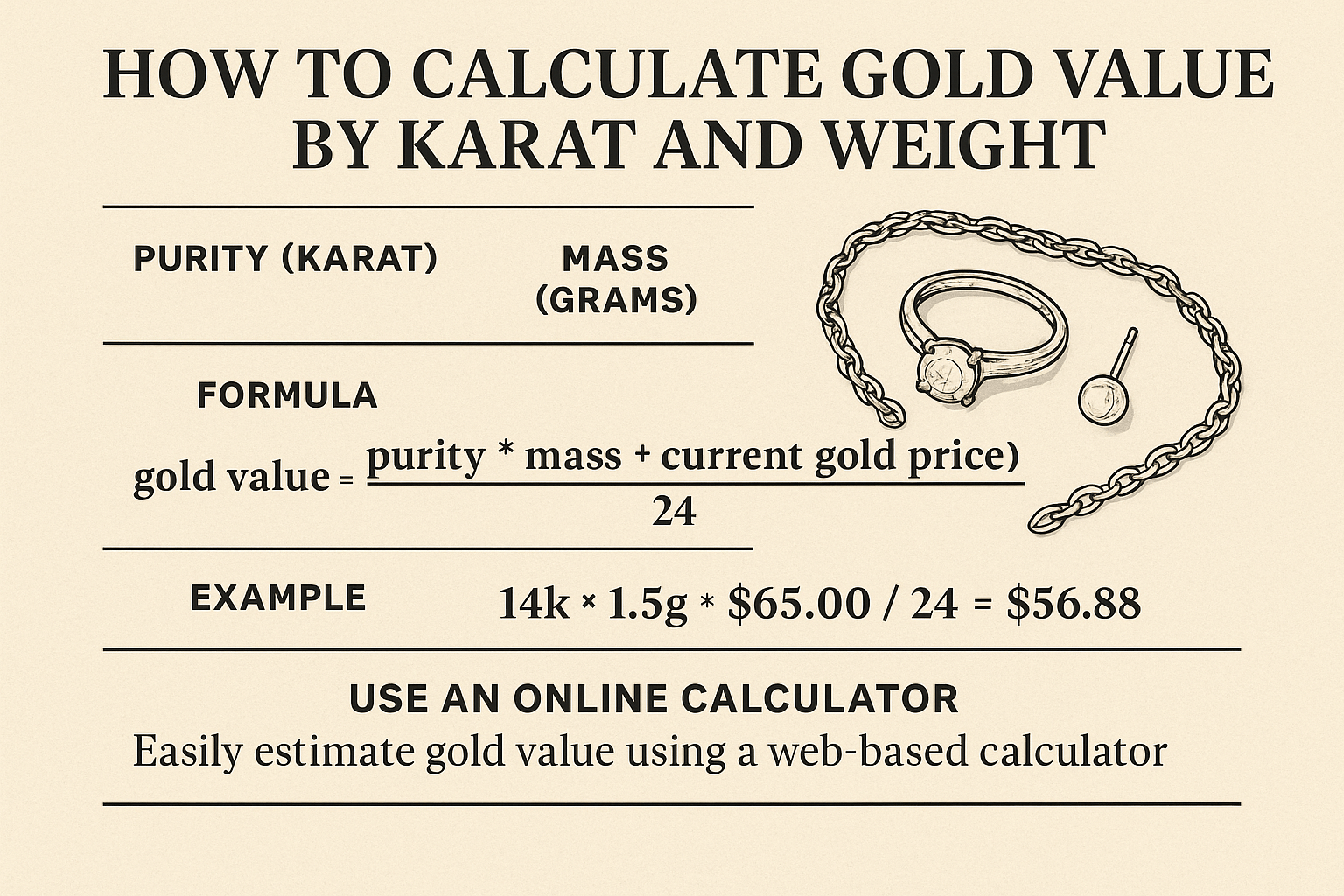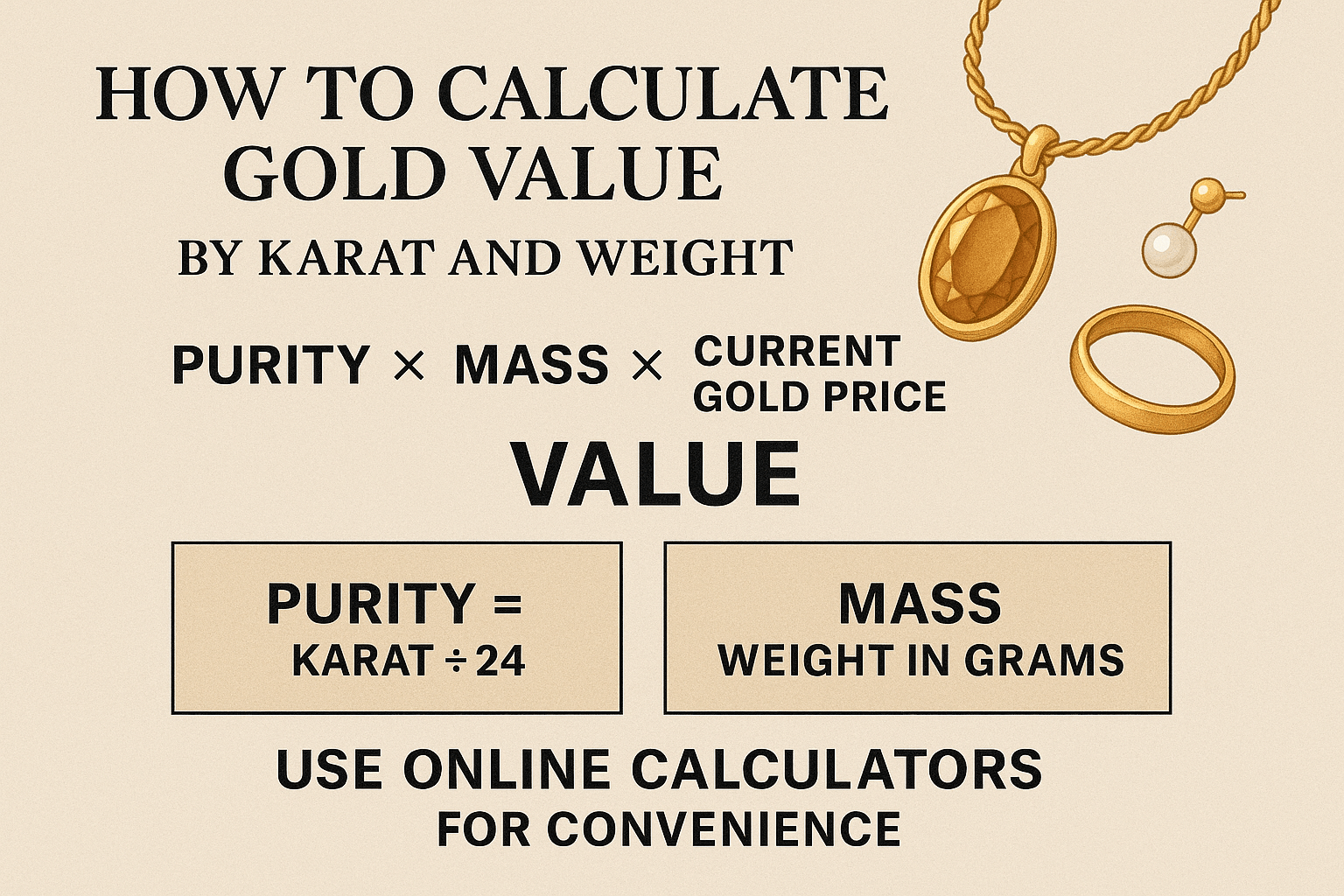That old necklace from your grandmother, a forgotten (calculate gold value by karat and weight) ring in a drawer, or a single earring—we’ve all wondered, “What is this actually worth?” The answer lies in understanding its fundamental components: purity and mass. Learning how to calculate gold value by karat and weight is an essential skill for anyone looking to sell, buy, or simply appraise their gold items. This guide will demystify the process, explain the crucial formulas, and show you how to use online tools like a pro, ensuring you get a fair deal every time.
Why You Can’t Just Weigh It and Multiply
If you were to take a 10-gram ring to three different buyers and get three wildly different quotes, you’d quickly realize that weighing it on a scale is only the first step. Pure, 24-karat gold is too soft for most jewelry, so it’s mixed with other metals like copper, silver, or zinc to create a more durable alloy. The karat (kt or k) system tells us the proportion of pure gold in that alloy.
This is the most critical concept to grasp:
-
24-karat gold is 100% pure gold.
-
18-karat gold is 18 parts gold and 6 parts other metals, making it 75% pure.
-
14-karat gold is 14 parts gold and 10 parts other metals, making it 58.3% pure.
-
10-karat gold (the minimum to be called “gold” in the U.S.) is 10 parts gold and 14 parts other metals, making it 41.7% pure.
When you calculate gold value by karat and weight, you are first determining the actual amount of pure gold in your item, known as its melt value or intrinsic value.

The Gold Value Calculation Formula: Breaking It Down
The global price of gold is known as the spot price. It is set by commodities markets like LBMA (London Bullion Market Association) and is quoted per Troy Ounce (which is different from a standard ounce—a Troy Ounce equals 31.1 grams).
Here is the step-by-step manual process to calculate your gold’s value:
-
Find the Live Gold Spot Price: This changes constantly throughout the trading day. A simple search for “gold spot price” will yield results from sites like Kitco or JMBullion. Let’s say the current price is $2,000 per Troy Ounce.
-
Convert the Spot Price to Grams: Since most people use grams, we need to convert.
-
Price per gram = Spot Price / 31.1
-
$2,000 / 31.1 ≈ $64.31 per gram (for pure, 24k gold)
-
-
Determine Your Gold’s Purity Percentage: Convert the karat rating into a decimal percentage.
-
10k = 10/24 = 0.4167 (or 41.67%)
-
14k = 14/24 = 0.5833 (or 58.33%)
-
18k = 18/24 = 0.7500 (or 75%)
-
22k = 22/24 = 0.9167 (or 91.67%)
-
-
Weigh Your Item: Use a precise digital scale, preferably one that measures in grams. Remember to weigh the item alone, without any stones, non-gold parts, or packaging. Let’s say your 14k gold chain weighs 15 grams.
-
Do the Math:
-
Multiply the weight by the purity percentage to find the amount of pure gold.
-
15 grams × 0.5833 = 8.75 grams of pure gold.
-
-
Multiply the pure gold weight by the price per gram of pure gold.
-
8.75 grams × $64.31 = $562.71
-
-
This $562.71 is your item’s approximate melt value—the base value of the raw precious metal content.
https://images.unsplash.com/photo-1586023492125-27a15c5465d2?ixlib=rb-4.0.3&ixid=MnwxMjA3fDB8MHxwaG90by1wYWdlfHx8fGVufDB8fHx8&auto=format&fit=crop&w=1000&q=80 Alt Text: Calculate gold value by karat and weight using a scale and online tools.
The Power of Online Gold Calculators
While the manual formula is great for understanding the process, online calculators are faster, eliminate human error, and automatically pull in the live spot price.
How They Work:
-
You find a reputable calculator on a bullion dealer or jewelry site (e.g., APMEX, Kitco, or local jeweler sites).
-
You select the karat (e.g., 14k) from a dropdown menu.
-
You enter the weight of your item (e.g., 15 grams).
-
The calculator instantly displays the estimated value.
These tools have the purity percentages and current spot price already programmed in, performing the same calculation we did above in a fraction of a second.
A Word of Caution: The value these calculators provide is the melt value. It is the maximum a refiner would pay. A local jeweler or pawn shop will offer less—often 70% to 85% of this value—to cover their refining costs, overhead, and profit margin. Antique or designer pieces may have additional “collector’s value” or artistic merit that can exceed the melt value, but this requires a specialized appraiser.

Factors That Influence the Final Offer
Understanding how to calculate gold value by karat and weight gives you powerful negotiating leverage. However, be aware of these factors:
-
The Buyer’s Business Model: A refiner who melts the gold will pay closest to the melt value. A jeweler who resells it may pay a bit less. A pawn shop offering immediate cash will offer the least.
-
Market Volatility: The spot price can swing dramatically based on global economic news, inflation data, and currency strength. Timing your sale can impact the final amount.
-
Condition of the Item: For melt value, condition is irrelevant. A broken chain is worth the same as a perfect one by weight and purity. However, if the item is a desirable brand (like Cartier) or a rare antique, its value as a finished good is higher.
Case Study: Selling a 18k Gold Bracelet
Let’s imagine you want to sell a solid 18k gold bracelet weighing 20 grams. The spot price is $2,050 per Troy Ounce.
-
Manual Calculation:
-
Price per gram = $2,050 / 31.1 = ~$65.91
-
Purity of 18k = 18/24 = 0.75
-
Pure gold content = 20g × 0.75 = 15g
-
Melt Value = 15g × $65.91 = $988.65
-
-
Realistic Offer:
-
A buyer offering 80% of melt value would offer: $988.65 × 0.80 = $790.92
-
Armed with this knowledge, if a buyer offers you $500, you can confidently (and politely) explain your calculation and negotiate from a position of strength.
Conclusion: Knowledge is Power (and Profit)
Whether you’re cleaning out an estate, selling unused jewelry, or making an investment, knowing how to calculate gold value by karat and weight is non-negotiable. It transforms you from an uninformed seller into a savvy negotiator. Use online calculators for speed, but understand the math behind them to verify the numbers. Always get multiple quotes from reputable buyers, from local jewelers to national bullion dealers. Your gold has a precise, calculable value—now you have the tools to ensure you receive every dollar you deserve for it.
Frequently Asked Questions (FAQs)
Q: Where is the karat marking on my jewelry?
A: Look for tiny stamps, often inside rings, on the clasp of necklaces, or on the posts of earrings. Common stamps include “24k,” “18k,” “750” (for 18k), “585” (for 14k), “417” (for 10k), or simply “10k,” “14k,” etc.
Q: What if my gold item has no karat stamp?
A: The absence of a stamp doesn’t mean it’s not gold. It could be worn off or was never stamped. The only way to be sure is to have it tested by a jeweler, often with a simple acid test or electronic tester.
Q: Is the value calculated the same for white gold and rose gold?
A: Yes. The karat stamp defines the purity of gold content regardless of its color. White gold is an alloy of gold with white metals like nickel or palladium, and rose gold is alloyed with copper. A 14k white gold ring and a 14k yellow gold ring of the same weight will have the same melt value.
Q: How often does the gold spot price change?
A: It changes in real-time during market hours (Monday-Friday). It’s influenced by global trading, so it can update every few seconds.
Q: Do online calculators value gemstones or diamonds?
A: No, absolutely not. Online gold calculators only value the precious metal content. Stones, even diamonds, are considered separate and must be appraised by a gemologist. In many cases, the setting may be worth more than the stone, and vice versa.
Disclaimer: This article is for educational and informational purposes only and does not constitute financial or professional advice. The gold market is volatile, and calculations are estimates. The actual value you receive for gold items may vary based on the buyer, market conditions, and the item’s characteristics. We do not guarantee the accuracy of any calculations or information from external links. If you believe any content infringes upon your rights, please visit our DMCA page to review our policy and procedures for content removal. Please verify the ownership of any items you sell and ensure you are complying with all local laws and regulations.
